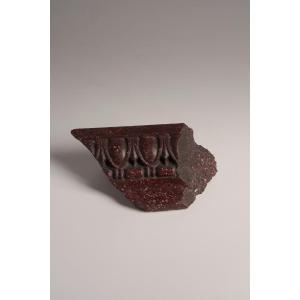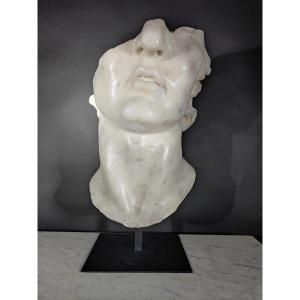Fragment of a red porphyry cornice, made in the 19th century in the context of the renewed interest in ancient forms. The object, although not ancient itself, imitates the stylistic codes of Greco-Roman architecture, particularly those of decorative friezes. It features a regular pattern of drops (or ovoids) framed by stylized vertical bands, evoking the rosary ornaments found on classical entablatures or cornice moldings.
These elements are carved in slight relief, with a regularity that suggests careful but artisanal execution, probably intended for decorative use.
The material used, Egyptian red porphyry, has strong symbolic and historical value. It recalls Roman imperial productions, where this type of stone, particularly difficult to work, was reserved for official monuments, imperial sarcophagi, or the columns of prestigious buildings.
Its use in the 19th century was both an aesthetic choice and a gesture of reference to idealized Antiquity. This fragment was most likely produced for wealthy European travelers, lovers of Antiquities or their replicas, who brought back from their Mediterranean journeys objects intended to constitute amateur cabinets. It thus testifies to a double approach: that of the historicizing reproduction specific to the 19th century, and that of the construction of a private memory of Antiquity.
The absence of a precise context of discovery and the traces of breakage visible on the right side indicate a fragmentary origin, probably from a larger decorative element, of which only a portion remains here.
Height: 6cm
Length: 13cm
Depth: 5cm


































 Le Magazine de PROANTIC
Le Magazine de PROANTIC TRÉSORS Magazine
TRÉSORS Magazine Rivista Artiquariato
Rivista Artiquariato